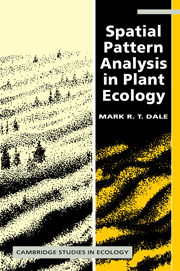Book contents
- Frontmatter
- Contents
- Preface
- 1 Concepts of spatial pattern
- 2 Sampling
- 3 Basic methods for one dimension and one species
- 4 Spatial pattern of two species
- 5 Multispecies pattern
- 6 Two-dimensional analysis of spatial pattern
- 7 Point patterns
- 8 Pattern on an environmental gradient
- 9 Conclusions and future directions
- Bibliography
- Glossary of abbreviations
- List of plant species
- Index
9 - Conclusions and future directions
Published online by Cambridge University Press: 04 December 2009
- Frontmatter
- Contents
- Preface
- 1 Concepts of spatial pattern
- 2 Sampling
- 3 Basic methods for one dimension and one species
- 4 Spatial pattern of two species
- 5 Multispecies pattern
- 6 Two-dimensional analysis of spatial pattern
- 7 Point patterns
- 8 Pattern on an environmental gradient
- 9 Conclusions and future directions
- Bibliography
- Glossary of abbreviations
- List of plant species
- Index
Summary
Summary of recommendations
In order to study spatial pattern and to answer questions about the relationship between the pattern and the processes that either give rise to it or are affected by it, we need to be able to detect pattern reliably and to quantify its characteristics. The highest quality data for pattern analysis come from strings or grids of relatively small contiguous quadrats in which some quantitative measure of species' densities has been recorded, or from the direct mapping of individual plant units such as stems. Even with the best data, no single method of analysis can quantify all the important characteristics of pattern.
For contiguous quadrat data, three-term local quadrat variance (3TLQV) and new local variance (NLV) form a good combination of methods to evaluate single-species pattern (Chapter 3). These methods detect the scales of pattern and the size of the smaller phase; the intensity associated with a 3TLQV peak can be used to evaluate the consistency of the pattern. For two species, three-term local quadrat covariance (3TLQC) is recommended; paired quadrat covariance (PQC) cannot be used because of the effects of resonance peaks, and the correlation coefficient cannot be used by itself to detect scale (Chapter 4). Multispecies pattern is best investigated using the modified multiscale ordination (MSO) technique based on 3TLQV; among its advantages are an evaluation of the evenness of the species' contributions to the multispecies pattern (Chapter 5).
- Type
- Chapter
- Information
- Spatial Pattern Analysis in Plant Ecology , pp. 277 - 296Publisher: Cambridge University PressPrint publication year: 1999



